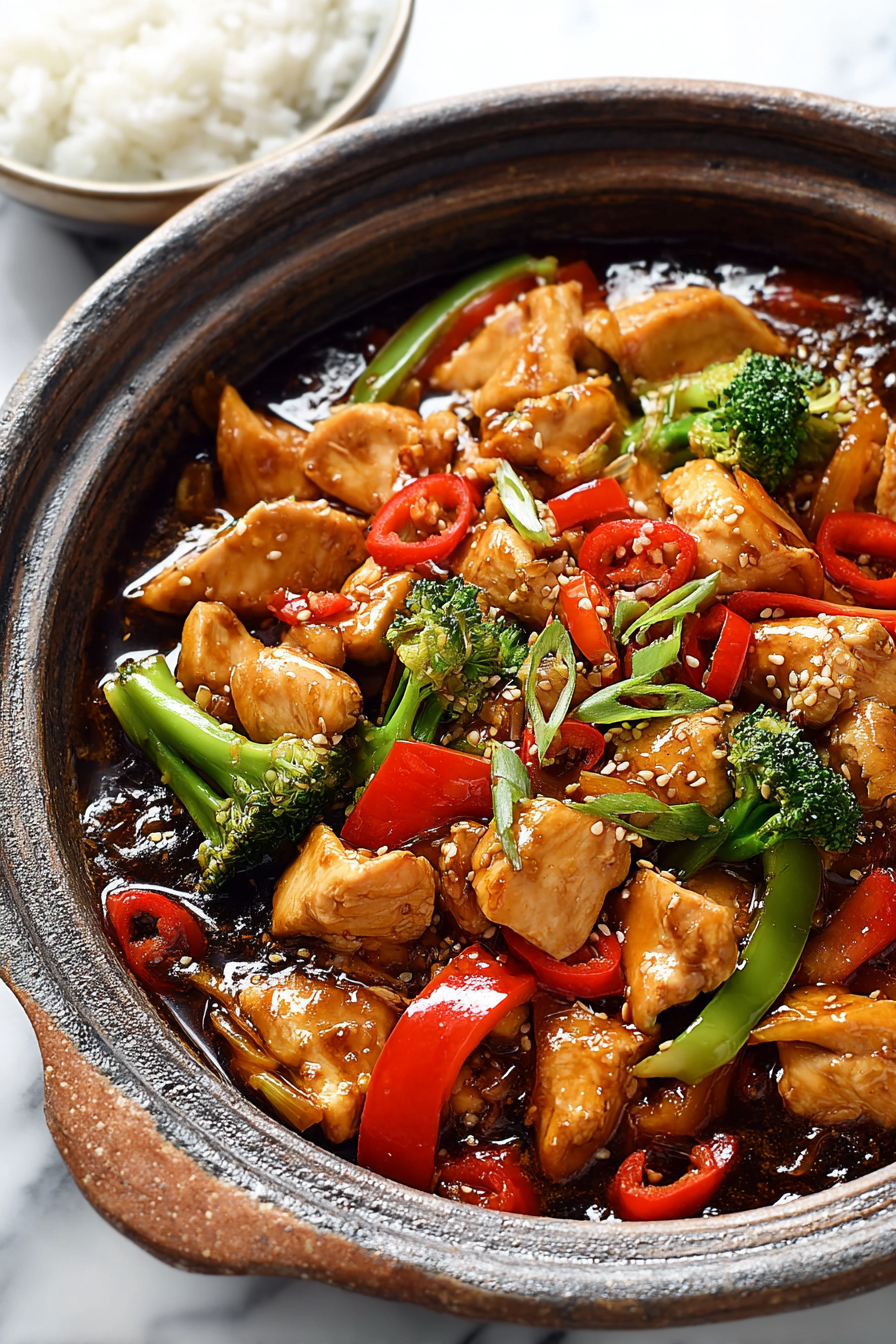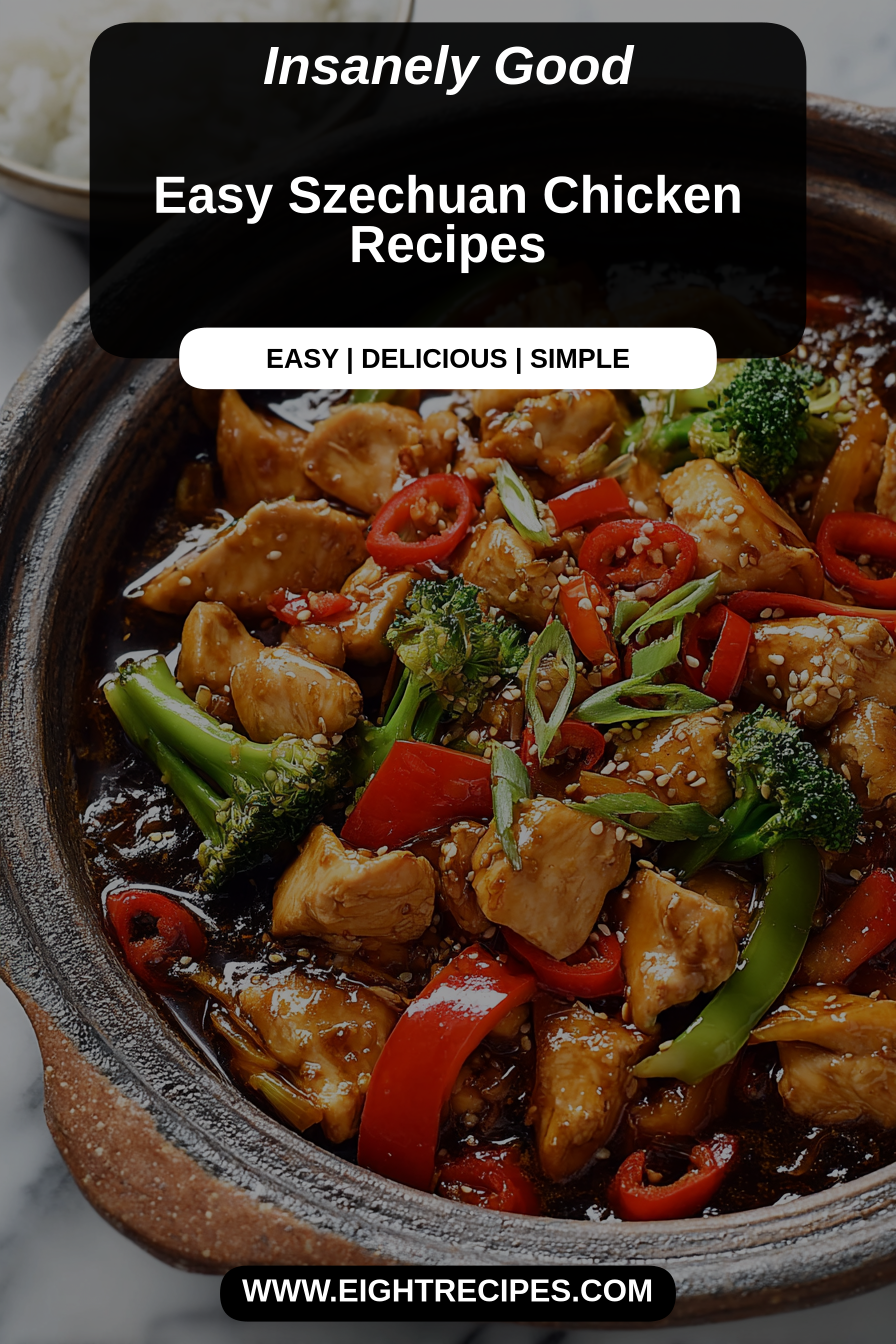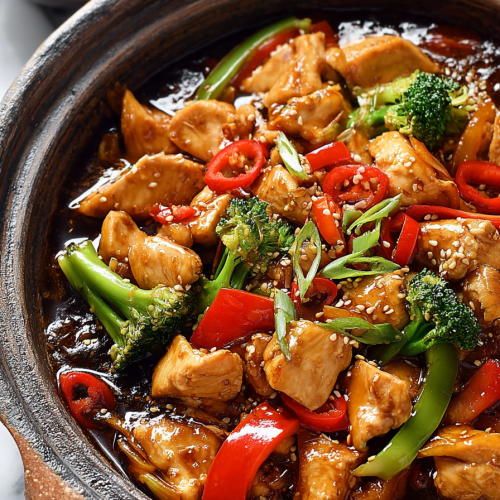Easy Szechuan Chicken Recipes

This Szechuan chicken is the kind of weeknight win I turn to when I want big, bright flavors without a ton of fuss: spicy, slightly numbing from Sichuan peppercorns, and lacquered in a glossy, savory-sweet sauce that clings to crisp-tender chicken and vegetables. It’s fast, forgiving, and — most importantly — endlessly adaptable for whatever’s in your fridge.
My husband practically requests this on repeat. He loves heat, so I dial the chiles up for him and leave a milder bowl for the kids; it’s become our compromise dinner. One chilly Tuesday, I served it over rice with a quick cucumber salad and watched everyone clear their plates before I could refill a single serving. That moment — the squeal of satisfaction and the “make this again” chorus — was when the dish went from “recipe” to “staple” in our house.
Why You’ll Love This Easy Szechuan Chicken Recipes
– Bold, layered flavors: there’s brightness from rice vinegar, umami from soy, and that signature numbing citrusy note from Sichuan peppercorns.
– Fast enough for weeknights: most of the cooking is high-heat, quick searing and stir-frying, so dinner is on the table in 30 minutes.
– Flexible to your pantry: swap proteins or vegetables, adjust the heat, and the core technique and sauce still shine.
– Family-friendly adaptability: serve milder portions for kids and punchier ones for adults without extra fuss.
– Texture play: a light cornstarch coating gives the chicken a slightly crisp exterior that soaks up sauce beautifully.
Behind the Recipe
This is a stir-fry built on contrasts: quick-seared chicken, crunchy vegetables, and a sauce that thickens just enough to coat everything. The key lesson I learned is to respect heat and timing — get your wok or skillet hot, work in batches so ingredients sear instead of steam, and finish the sauce off with a cornstarch slurry to the exact gloss you like. Little touches that elevate the dish are toasting whole Sichuan peppercorns briefly before grinding for maximum aroma, and adding a splash of toasted sesame oil at the end for warmth. Don’t rush the stir-fry, but don’t overcomplicate it either; the magic is in the balance.
Shopping Tips
– Protein: Choose boneless, skinless chicken thighs for juiciness (breasts work but watch cooking time). If using pre-cut pieces, pick consistent sizes to ensure even cooking.
– Spices: Seek out Sichuan peppercorns and dried chiles (like whole dried red chiles or fave flakes). Toasting whole peppercorns briefly in a dry pan brightens their flavor.
– Vegetables: Use crisp vegetables — bell peppers, snap peas, and scallions are ideal. Buy firm, vibrant produce for the best texture after high-heat cooking.
– Fats & Oils: Use a neutral high-heat oil (canola, peanut, or vegetable) for stir-frying and keep a small bottle of toasted sesame oil for finishing — a little goes a long way.
– Specialty Item: Doubanjiang or Szechuan chili paste adds authentic depth; if you can’t find it, substitute with a combination of chili paste and a little miso for umami.
Prep Ahead Ideas
– Marinate the chicken (with a splash of soy, a pinch of cornstarch, and a little rice wine or mirin) up to 24 hours ahead; it tenderizes and absorbs more flavor.
– Chop all vegetables and slice aromatics the day before; store in airtight containers or zip bags in the fridge.
– Mix the sauce ingredients in a jar in advance and keep the cornstarch separate until cooking; this lets you pour and go during a busy evening.
– If you bread the chicken lightly with cornstarch, you can do that step ahead and refrigerate it on a tray for a couple hours before cooking.
Time-Saving Tricks
– Buy pre-sliced boneless chicken or ask the butcher to slice it for you to shave prep time.
– Use pre-minced garlic and ginger or a jarred paste in a pinch — fresh is best, but the paste keeps things speedy.
– Cook in one large pan or wok and do the chicken and veg in quick batches to maintain high heat without cooling the pan down.
– Clean as you go: while one batch rests, wipe the pan, chop the next veg, and have the sauce within arm’s reach to keep momentum.
– Slowing down: let the sauce simmer a minute at the end to concentrate flavors; that small pause really improves the finish.
Common Mistakes
– Overcrowding the pan: I did this once and ended up with boiled-looking chicken. Cook in batches so each piece gets a proper sear.
– Overcooking the chicken: small, consistent pieces sear quickly; watch for just-cooked through to keep bites juicy.
– Watery sauce: too much liquid from veggies or a cold pan causes the sauce to fail to thicken. Reduce the sauce briefly then add a cornstarch slurry to reach the right gloss.
– Skipping the finishing oil: leaving out toasted sesame oil robs the dish of depth — add it at the end, off the heat, for aroma.
– Too spicy, too fast: add chiles conservatively during testing and let people adjust at the table with chili oil or flakes.
What to Serve It With
– Steamed jasmine or short-grain rice to soak up the sauce.
– Stir-fried noodles or even quick fried rice for a heartier meal.
– Simple sides like cucumber salad, quick-pickled radishes, or steamed bok choy to cut the richness.
– A few scallion pancakes or steamed buns make it feel more restaurant-style and are great for mopping.
Tips & Mistakes
Serve hot and straight from the pan when possible — the sauce is at its best then. If you want contrast, a cool cucumber salad on the side balances heat beautifully. If a pan gets smoking, turn down the heat briefly and let it rest; continuing on a choked, overheated pan often leads to burnt aromatics.
Storage Tips
Store in airtight containers in the fridge. It reheats beautifully, but if you sneak a bite cold straight from the container, it still works.
Variations and Substitutions
– Protein swaps: firm tofu (pressed and pan-fried), thinly sliced beef, or shrimp work well; adjust cooking times accordingly.
– Sauce swaps: tamari or coconut aminos for gluten-free; honey or maple for a different sweet note in place of sugar.
– Heat adjustments: omit Sichuan peppercorns for less numbing effect, or reduce the dried chiles if you want it milder.
– Vegetable swaps: broccoli, snow peas, or carrots are sturdy options that hold up to high heat.
– Keep in mind: doubanjiang adds a distinctive fermented depth that’s hard to perfectly replicate; if you can find it, it’s worth using.

Write me the frequently asked questions and answers Easy Szechuan Chicken Recipes in the same way as the example below.
Frequently Asked Questions

Easy Szechuan Chicken Recipes
Ingredients
Main Ingredients
- 1.5 lb boneless, skinless chicken thighs You can also use chicken breasts if preferred.
- 2 tbsp vegetable oil
- 3 tbsp Szechuan sauce Store-bought or homemade.
- 1 cup bell peppers Chopped, any color.
- 0.5 cup onion Chopped.
- 2 cloves garlic Minced.
- 0.5 cup chicken broth Low-sodium is recommended.
- 1 tbsp soy sauce
- 1 tbsp cornstarch For thickening.
- 1 tbsp water To mix with cornstarch.
Instructions
Preparation Steps
- Start by cutting the chicken thighs into bite-sized pieces and season them lightly with salt and pepper. Heat the vegetable oil in a large skillet over medium-high heat, then add the chicken. Cook until golden brown and cooked through, about 7-10 minutes, stirring occasionally.
- Add in the chopped bell peppers, onion, and garlic to the skillet. Sauté everything together until the veggies are tender, about 5 minutes. This adds a lovely crunch and flavor!
- Pour in the Szechuan sauce and chicken broth, stirring well to combine. In a small bowl, whisk together the cornstarch and water, then add to the skillet to thicken the sauce, stirring constantly until the sauce has thickened, for about 2-3 minutes.
- Serve the Szechuan chicken over rice or noodles, garnished with green onions if desired. Enjoy a dish that’s both zesty and satisfying!
